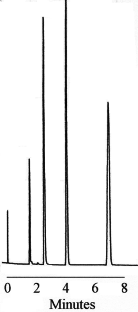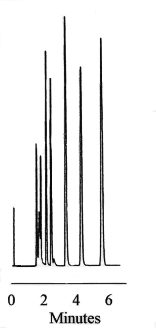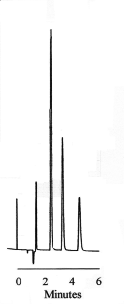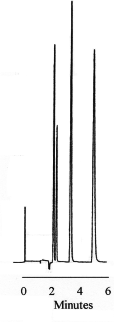
Exsil Pure RP18
In recent years, high purity silicas bonded with monofunctional C18 and fully end capped have become the standard phase for difficult analyses. The success of this approach is evidenced by the large number of these phases available. They do have some drawbacks; these being primarily tailing with some bases at neutral pH and a high degree of similarity in selectivity. Despite these drawbacks, such phases are popular and we have produced such a phase on Exsil Pure.
Exsil Pure RP18
- Phase: Octadecyl, end capped
- Particle Size: 1.5, 3, 5, 7 and 10µm
- Base Silica: Exsil Pure 120A
- Particle Size: 1.5, 3, 5, 7 and 10µm
This features:
- High Purity Silica: Good chromatography of acids and bases
- High efficiency: Typically 85-105,000 plates/m for 5mm
- Cost effective: High performance at low cost.
- Reproducible: Typical Exmere reliability
- High pH Stability: pH 12 clean in situ.
pH 3 General Purpose
Low pH buffered systems are often preferred for general analysis as they give the best peak shape and efficiency for basic compounds while allowing adequate retention of acids.
Column: 150 x 4.6 mm
Phase: 5µm Exsil Pure RP18
Eluent: 50% MeCN/50% 50mM KH2PO4 pH 3 at 35oC
Sample: Pyridine and Phenol
Stronger acids and bases can sometimes show up deficiencies in phases. This separation of the strong base Amitriptyline and the carboxylic acid, Phenylvaleric acid shows good peak shape and high efficiency leading to excellent all round performance
Column: 150 x 4.6 mm
Phase: 5µm Exsil Pure RP18
Eluent: 50% MeCN/50% 50mM KH2PO4 pH 3 at 35oC
Sample: Uracil, Amitriptyline, Phenylvaleric acid, Toluene
Further illustrating the performance on difficult samples is the simultaneous separation of four bases and three acids. These bases and acids have proved difficult to separate with good peak shape on some phases. The Phenoxy acetic acid in particular is prone to tailing and is more probing in this respect than Butylbenzoic acid.
Column: 150 x 4.6 mm
Phase: 5µm Exsil Pure RP18
Eluent: 50% MeCN/50% 50mM KH2PO4 pH 3 at 35oC
Sample: Uracil, Amitriptyline, Phenylvaleric acid, Toluene
Sample: Nicotine, (2 impurities), Quinine, Diphenhydramine, Nortriptyline, 2,4,Dichlorophenoxy acetic, propionic and butyric acids
pH 7 Alternative Selectivity/Higher Base Retention
Neutral pH has found use for basic compounds where either a change in selectivity compared with low pH is required or higher retention is desired to aid detection in LC/MS. Phosphate buffers have been used in numerous commercial and academic publications but their involatility limits their use to non-MS applications.
Performance is maintained with volatile buffers such as ammonium formate with a reduction in the retention of bases when using the ammonium cation. In this case, the retention of Amitriptyline reduces from k’ 4.4 to k’ 1.2. This can lead to cost savings in routine analysis due to less of the organic component being needed. However for LCMS, the higher water content of the eluent reduces sensitivity.
Eluent: 80% MeOH, 20% 50mM ammonium formate, pH7
Column: 150 x 4.6 mm
Sample: Procaine, Nortriptyline, Doxepin, and Amitriptyline
pH 10 Highest Base Retention and Performance
Although use at neutral pH can help in improving MS detection, higher pH’s can give additional benefits such as longer retention allowing the use of lower water content eluents with a consequent increase in MS sensitivity. In addition high pH also gives better peak shape and higher efficiency. Low levels of ammonia (0.1% v/v of SpG 0.88 g/l ammonia solution) have become a popular choice to deliver these benefits and eluent preparation is simpler as there are no solids to be weighed or pH to adjust.
Doxepin, Amitriptyline and Nortriptyline are well known for being difficult to chromatograph. A high pH suppresses ionisation and allows ready separation of these strong bases with excellent peak shape and good efficiency.
Eluent: 90% MeOH, 9.9% water, 0.1 % 0.88 ammonia at 1.5 ml/min
Column: 150 x 4.6 mm
Sample: Procaine, Doxepin, Amitriptyline, and Nortriptyline
pH 12 High pH Stability
It is a common assertion that silica based media cannot be used at high pH (>pH 8) and that pure silicas are particularly prone to dissolution at high pH due to the absence of stabilising Al cations in the matrix. This may be the case for conventional (TEOS) high purity silicas, but the unique Exsil process produces silicas of outstanding stability.
The attached chromatograms show the minimal effect that 50% 10mM NaOH (pH 12)/ 50% MeOH has on Exsil Pure RP18 after 100 hours and 2500 column volumes.
Initial
After 2500 column volumes and 100 hours, 50% MeOH/50% 10 mM NaOH
Column: 50 x 4.6 mm Exsil Pure RP18 5µm
Eluent: 50% MeCN/50% 50mM KH2PO4,, pH3 @ 1ml/min and 35oC
Sample: Uracil, Amitriptyline, Phenylvaleric acid and Toluene
Although it is unlikely that these conditions would be used for routine analysis as sodium hydroxide is a weak buffer and involatile, the results indicate the exceptional high pH stability would allow the use of high pH eluents to clean Exsil Pure RP18 in situ.








